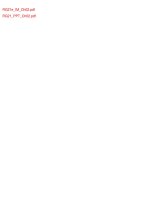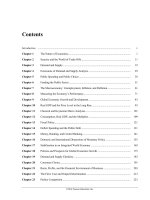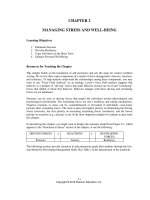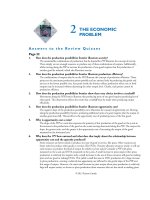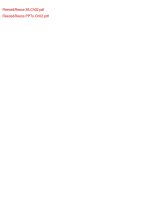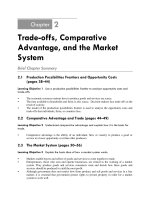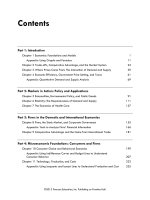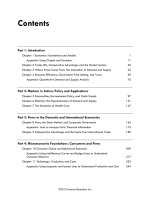Test bank and solution manual of economics 2e by obrien (2)
Bạn đang xem bản rút gọn của tài liệu. Xem và tải ngay bản đầy đủ của tài liệu tại đây (627.11 KB, 20 trang )
2
Trade-offs, Comparative
Advantage, and the Market
System
Chapter
Brief Chapter Summary
2.1 Production Possibilities Frontiers and Opportunity Costs
(pages 38–44)
Learning Objective 1 Use a production possibilities frontier to analyze opportunity costs and
trade-offs.
The economic resources nations have to produce goods and services are scarce.
The time available to households and firms is also scarce. Decision-makers face trade-offs as the
result of scarcity.
The model of the production possibilities frontier is used to analyze the opportunity costs and
trade-offs that individuals, firms, or countries face.
2.2 Comparative Advantage and Trade (pages 44–49)
Learning Objective 2 Understand comparative advantage and explain how it is the basis for
trade.
Comparative advantage is the ability of an individual, firm, or country to produce a good or
service at a lower opportunity cost than other producers.
2.3 The Market System (pages 50–56)
Learning Objective 3 Explain the basic idea of how a market system works.
Markets enable buyers and sellers of goods and services to come together to trade.
Entrepreneurs, those who own and operate businesses, are critical to the working of a market
system. They produce goods and services consumers want and decide how these goods and
services should be produced to yield the most profit.
Although government does not restrict how firms produce and sell goods and services in a free
market, it is essential that government protect rights to private property in order for a market
system to work well.
24 CHAPTER 2 | Trade-offs, Comparative Advantage, and the Market System
Chapter Outline
Managers Making Choices at BMW
The managers at firms such as BMW (the Bavarian Motor Works) must make decisions regarding the
production and marketing of their products. These decisions include the location and relocation of
manufacturing plants and the production methods used at these plants.
>>
Teaching Tips
The authors use BMW as an extended example in the chapter to explain
the production possibilities frontier. An Inside Look at the end of the
chapter discusses the tradeoffs BMW managers face when making
production decisions given the size of the manufacturing plan and
technology used at the plant. After you have gone through the chapter in
class, ask your students to read An Inside Look as the basis for
classroom discussion.
Economics in Your Life asks students to consider the trade-offs
they face when purchasing a car. The authors return to this example at
the end of the chapter.
2.1 LEARNING OBJECTIVE
2.1 Production Possibilities Frontiers and Opportunity Costs
(pages 38-44)
Learning Objective 1 Use a production possibilities frontier to analyze opportunity costs and
trade-offs.
A graph of a linear production possibilities frontier (PPF) is used to illustrate the trade-off BMW faces in
deciding how many roadsters and SUVs it should produce given its limited resources and technology.
A production possibilities frontier is a curve showing the maximum attainable combinations of two
products that may be produced with available resource and current technology.
A. Graphing the Production Possibilities Frontier
Combinations of products on the frontier are technically efficient because the maximum output is
obtained from the available resources. Combinations inside the frontier are inefficient because some
resources are not being used. Combinations outside the frontier are unattainable with current resources.
Opportunity cost is the highest-valued alternative that must be given up to engage in an activity.
B. Increasing Marginal Opportunity Costs
A convex or “bowed out” PPF illustrates increasing marginal opportunity costs. Increasing marginal
opportunity costs occur because some workers, machines, and other resources are better suited to one use
CHAPTER 2 | Trade-offs, Comparative Advantage, and the Market System 25
than another. Increasing marginal opportunity costs illustrate an important concept: the more resources
already devoted to any activity, the smaller the payoff to devoting additional resources to that activity.
Economic growth will shift a PPF to the right.
C. Economic Growth
Economic growth is the ability of the economy to produce increasing quantities of goods and services.
Economic growth can occur if more resources become available or if a technological advancement makes
resources more productive. Growth may lead to greater increases in production for one good than another.
>>
Teaching Tips
Encourage students to use Solved Problem 2-1 to understand how
production possibilities frontiers illustrate opportunity costs and tradeoffs. The PPF is the first of many graphs students will see in the
textbook, and many students will have initial difficulty measuring and
understanding the slope of the frontier. Refer to Making the Connection:
Trade-offs: Hurricane Katrina, Tsunami Relief and Charitable Giving
for an explanation of the trade-offs charitable organizations face when
aid solicited as a result of a natural disaster causes a reduction in their
financial support. Even those who believe contributions to tsunami relief
efforts are laudable will have difficulty supporting these efforts if they
are at the expense of homeless shelters or cancer research.
2.2 LEARNING OBJECTIVE
2.2 Comparative Advantage and Trade (pages 44–49)
Learning Objective 2 Understand comparative advantage and explain how it is the basis for trade.
Trade is the act of buying or selling. One of the great benefits of trade is that it makes it possible for
people to become better off by increasing both their production and their consumption.
A. Specialization and Gains from Trade
PPFs depict the combinations of two goods that can be produced if no trade occurs. If one individual’s PPF
shows greater production of both goods, this individual has an absolute advantage in producing both goods.
B. Absolute Advantage versus Comparative Advantage
Absolute advantage is the ability of an individual, firm, or country to produce more of a good or service
than competitors using the same amount of resources. Each individual will have a comparative advantage
in the production of one of the goods if the two individuals have different opportunity costs for producing
each good.
Comparative advantage is the ability of an individual, firm, or country to produce a good or service at a
lower opportunity cost than other producers. Comparing the possible combinations of production and
consumption before and after specialization and trade occur proves that trade is mutually beneficial.
26 CHAPTER 2 | Trade-offs, Comparative Advantage, and the Market System
C. Comparative Advantage and the Gains from Trade
The basis for trade is comparative advantage, not absolute advantage. Individuals, firms, and countries
are better off if they specialize in producing the goods and services for which they have a comparative
advantage and obtain the other goods and services they need by trading.
>>
Teaching Tips
Even good students have difficulty understanding comparative
advantage. Assign Solved Problem 2-2 for homework. You can ask
students to explain the BEFORE TRADE and AFTER TRADE tables to
ensure their understanding of the problem. Encourage students to read
the feature Don’t Let This Happen to You! which warns them not to
confuse absolute with comparative advantage. Instructors struggle to find
examples of people who have had an absolute advantage in two different
areas but still benefit from specialization. A good example of this is the
career of baseball legend Babe Ruth. Before he achieved his greatest
fame as a home run hitter and outfielder with the New York Yankees,
Ruth was a star pitcher with the Boston Red Sox. Ruth may have been
the best left-handed pitcher in the American League during his years
with Boston (1914-1919), but he was used more and more as a fielder in
his last two years with the team. In fact, he established a record for home
runs in a season (29) in 1919. The Yankees acquired Ruth in 1920 and
made him a full-time outfielder. The opportunity cost of this decision for
the Yankees was the wins he could have earned as a pitcher. But since
New York already had skilled pitchers, the opportunity cost of replacing
him as a pitcher was lower than the cost of replacing Ruth as a hitter. No
one else on the Yankees could have hit 54 home runs, Ruth’s total in
1920; the next highest total was 11. It can be argued that Ruth had an
absolute advantage as both a hitter and pitcher in 1920, but a
comparative advantage only as a hitter.
2.3 LEARNING OBJECTIVE
2.3 The Market System (pages 50–56)
Learning Objective 3 Explain the basic idea of how a market system works.
A market is a group of buyers and sellers of a good or service and the institution or arrangement by
which they come together to trade. Product markets are markets for goods – such as computers – and
services – such as medical treatment. Factor markets are markets for the factors of production, such as
labor, capital, natural resources, and entrepreneurial ability.
A. The Circular Flow of Income
A circular-flow diagram is a model that illustrates how participants in markets are linked. The diagram
demonstrates the interaction between firms and households in both product and factor markets.
CHAPTER 2 | Trade-offs, Comparative Advantage, and the Market System 27
B. The Gains from Free Markets
A free market is a market with few government restrictions on how a good or service can be produced or
sold, or on how a factor of production can be employed. Adam Smith is considered the father of modern
economics. His book, An Inquiry into the Nature and Causes of the Wealth of Nations, published in 1776,
was an influential argument for the free market system.
C. The Market Mechanism
A key to understanding Smith’s argument is the assumption that individuals usually act in a rational, selfinterested way. This assumption underlies nearly all economic analysis.
D. The Role of the Entrepreneur
Entrepreneurs are an essential part of a market economy. An entrepreneur is someone who operates a
business, bringing together the factors of production — labor, capital, and natural resources — to produce
goods and services.
Entrepreneurs often risk their own funds to start businesses and organize factors of production to produce
those goods and services that consumers want.
E. The Legal Basis of a Successful Market System
The absence of government intervention is not enough for a market economy to work well. Government
has to provide secure rights to private property. Government can aid the working of a market by enforcing
contracts between individuals through an independent court system. Property rights refer to the rights
individuals or firms have to the exclusive use of their property, including the right to buy or sell it.
Intellectual property rights are important. To protect intellectual property rights, the federal government
grants inventors patents—exclusive rights to produce and sell a new product for 20 years from the date
the product was invented. Books, films, and software receive copyright protection. Under U.S. law, the
creator of a book, film, or piece of music has an exclusive right to use the creation. The creator’s heirs
retain this right for 50 years.
>>
Teaching Tips
Students first learn scarcity at home, in school, and in other non-market
settings. In these environments, scarce items are often allocated by
parents, teachers, or others who know those who receive these items;
therefore, fairness or equity is usually one criterion used to allocate
scarcity. But in markets, prices—not fairness—allocate scarce products.
Students seldom know the identity of the people who produce the
products they buy. The impersonal and decentralized character of
markets is illustrated very well by the reading found in Making the
Connection: A Story of the Market System in Action: How Do You
Make an iPod? The role of government in a free-market economy has
often been compared to that of an umpire or referee in a sporting event.
The most vocal critics of decisions made by these officials would not
argue for their elimination. It would not take long for a tennis match or
baseball game to turn into a shouting match (or worse!) if players were
28 CHAPTER 2 | Trade-offs, Comparative Advantage, and the Market System
allowed to interpret the rules of their own games. On the other hand, the
quality of sporting events suffers when officials bar players, coaches, or
managers from participating in contests for frivolous reasons. Making
the Connection: Property Rights in Cyberspace: YouTube and
MySpace describes the difficulty of protecting property rights in
cyberspace. To initiate class discussion, ask students these questions:
1. How many of you have downloaded music via the Internet? (Or
know someone who has?)
2. Should the government have the right to grant exclusive rights to
musicians and other artists to produce and sell their creative works?
3. Should the government fine or prosecute individuals who illegally
obtain music, books, movies, and other creative works in violation of
property rights laws?
Extra Solved Problem 2-3
Adam Smith’s “Invisible Hand”
Supports Learning Objective 3: Explain the basic idea of how a market system works.
Alan Krueger, an economist at Princeton University, has argued that Adam Smith “…worried that if
merchants and manufacturers pursued their self-interest by seeking government regulation and privilege,
the invisible hand would not work its magic…”
Source: Alan B. Krueger, “Rediscovering the Wealth of Nations,” New York Times, August 16, 2001.
a. What types of regulation and privilege might merchants and manufacturers seek from the
government?
b. How might these regulations and privileges keep the invisible hand from working?
SOLVING THE PROBLEM:
Step 1:
Review the chapter material.
This problem concerns how goods and services are produced and sold and how factors of
production are employed in a free market economic system as described by Adam Smith in
An Inquiry into the Nature and Causes of the Wealth of Nations. You may want to review the
section “The Gains from Free Markets,” which begins on page 52.
Step 2:
Answer question (a) by noting the economic system in place in Europe in 1776.
At the time, governments gave guilds – associations of producers – the authority to control
production. The production controls limited the amount of output of goods such as shoes and
clothing, as well as the number of producers of these items. Limiting production and
competition led to higher prices and fewer choices for consumers. Instead of catering to the
wants of consumers, producers sought the favor of government officials.
CHAPTER 2 | Trade-offs, Comparative Advantage, and the Market System 29
Step 3:
Answer question (b) by contrasting the behavior of merchants and manufacturers
under a guild system and a market system.
Because governments gave producers the power to control production, producers did not have
to respond to consumers’ demands for better quality, variety, and lower prices. Under a
market system, producers who sell poor quality goods at high prices suffer economic losses;
producers who provide better quality goods at low prices are rewarded with profits.
Therefore, it is in the self-interest of producers to address consumer wants. This is how the
invisible hand works in a free market economy, but not in Europe in the 18th century.
Extra Making Prices and Communication
the
Connection
Few economists have described the operation of a market system as eloquently as Friedrich A. Hayek
(1899-1992). Hayek noted that the knowledge needed by consumers and producers to make economic
decisions “never exists in concentrated…form but… as the dispersed bits of incomplete and frequently
contradictory knowledge …there is…a body of very important but unorganized knowledge…every
individual has some advantage over all others because he possesses unique information of which
beneficial use might be made, but of which use can be made only if the decisions depending on it are left
to him or are made with his active cooperation.” For example, a farmer in Kansas is an expert in the local
climate and soil conditions and the cost of various types of seed and fertilizer. “If we can agree that the
economic problem of society is mainly one of rapid adaptation to changes in particular circumstances of
time and place, it would seem to follow that the ultimate decisions must be left to the people who are
familiar with these circumstances.
“We must look at the price system as such a mechanism for communicating information if we want to
understand its real function…The most significant fact about this system is the economy of knowledge
with which it operates, or how little the individual participants need to know in order to be able to take the
right action… It is more than a metaphor to describe the price system as a … system of
telecommunications [italics added] which enables individual producers to watch merely the movement of
a few pointers, as an engineer might watch the hands of a few dials, in order to adjust their activities to
changes of which they may never know more than is reflected in the price movement.”
Hayek notes that most people take a market economy’s system of markets and prices for granted and
offered an explanation for this complacency. “I am convinced that if it were the result of deliberate
human design, and if the people guided by the price changes understood that their decisions have
significance far beyond their immediate aim, this mechanism would have been acclaimed as one of the
greatest triumphs of the human mind. Its misfortune is the double one that it is not the product of human
design and that the people guided by it usually do not know why they are made to do what they do.”
Source: Hayek, F.A. “The Use of Knowledge in Society,” American Economic Review, XXXV, No. 4, September 1945,
pp. 519-30.
30 CHAPTER 2 | Trade-offs, Comparative Advantage, and the Market System
Extra Making The Story of the Market System in
the Action: “I, Pencil”
Connection
The pencil seems like a very simple product. In fact, its production requires the coordinated activities of
many different people, spread around the world. The economist Leonard Read showed how markets achieve
this coordination by writing an “autobiography” of a pencil sold by the Eberhard Faber Pencil Company of
California. It is one of the most famous accounts of how the market system works. The pencil writes that:
My family tree begins with a [cedar] tree that grows in Northern California and
Oregon. Now contemplate all the saws and trucks and rope and the countless
other gear used in harvesting and carting the cedar logs to the railroad siding. . . .
The logs are shipped to a mill in San Leandro, California. . . . The cedar logs are
cut into small, pencil-length slats less than one-fourth of an inch in thickness. . . .
Once in the pencil factory . . . each slat is given eight grooves by a complex
machine, after which another machine lays leads in every other slat. . . .
My “lead” itself—it contains no lead at all—is complex. The graphite is mined in
[Sri Lanka] . . . [and] is mixed with clay from Mississippi in which ammonium
hydroxide is used in the refining process. . . . To increase their strength and
smoothness the leads are then treated with a hot mixture which includes
candelilla wax from Mexico, paraffin wax, and hydrogenated natural fats.
My cedar receives six coats of lacquer. Do you know all the ingredients of
lacquer? Who would think that the growers of castor beans and the refiners of
castor oil are a part of it? They are.
My bit of metal—the ferrule—is brass. Think of all the persons who mine zinc
and copper and those who have the skills to make shiny sheet brass from these
products of nature.
Then there’s my crowning glory . . . the part man uses to erase the errors he
makes with me. . . .It is a rubber-like product made by reacting rape-seed oil
from [Indonesia] with sulfur chloride. . . .Then, too, there are numerous
vulcanizing and accelerating agents. The pumice comes from Italy; and the
pigment which gives [the eraser] its color is cadmium sulfide.
Millions of human beings have had a hand in my creation, no one of whom even
knows more than a very few of the others. . . . There isn’t a single person in all
these millions, including the president of the pencil company, who contributes
more than a tiny, infinitesimal bit of know-how. . . .
There is a fact still more astounding: the absence of a master mind, of anyone
dictating or forcibly directing these countless actions which bring me into being. No
trace of such a person can be found. Instead, we find the Invisible Hand at work.
Source: Leonard E. Read, I, Pencil, Irvington-on-Hudson, NY: Foundation for Economic Education, Inc. 1999. Used with
permission of Foundation for Economic Education, Inc. Available online at www.econlib.org/library/Essays/rdPncl1.html.
CHAPTER 2 | Trade-offs, Comparative Advantage, and the Market System 31
Extra Economics in YOUR Life!
International Trade and Household Income
While much debate has surrounded the impact of international trade on employment and the degree to
which outsourcing has occurred, Ben Bernanke, Chairman of the Federal Reserve Board, cited a study
that examined the impact of trade on income in the U.S. since World War II: “…the increase in
trade…has boosted U.S. annual incomes on the order of $10,000 per household. The same study found
that removing all remaining barriers to trade would raise incomes anywhere from $4,000 to $12,000 per
household.”
Questions: (a) Should the United States eliminate all trade barriers if this increases the risk of some
workers losing their jobs to outsourcing? (b) What type of job would make you more or less vulnerable
to outsourcing?
Answers: (a) Given the opposition from firms and workers in industries that would be harmed by free
trade, it is unlikely that the United States would eliminate all trade barriers. But the studies cited by Ben
Bernanke indicate that opposition to free trade has a significant cost. (b) Another study cited by Bernanke
found that twenty-one occupations that were most vulnerable to outsourcing were primarily for relatively
lower-wage positions.
Source: Ben Bernanke, “Embracing the Challenge of Free Trade: Competing and Prospering in a Global Economy,” The
Federal Reserve Board, May 1, 2007. />
Extra INSIDE LOOK News Article to Use in Class
Here are extra Inside Look news articles and analyses to present in class. They are based on news articles
from the book’s Companion Web Site, www.prenhall.com/hubbard.
The Most Outrageous Stuff Sold Online
Mary Crane and Maureen Farrell
“The Most Outrageous Stuff Sold Online”
Posted 11/03/2006 on MSNBC.com
Forbes
Summary: Key Points in the Article
Online retailing is growing at a rate of 35 percent a year with 2005 sales exceeding $176 billion. Travel
accounted for about $62 billion of that amount with computer hardware and software coming in a distant
second place with $14 billion in last year’s sales. Automobiles and auto parts generated $13 billion in
sales revenue, clothing generated $11 billion and home furnishings generated $8 billion in sales revenue.
However, the online market also offers more esoteric items. You can buy your own private island, a
submarine ride to the Titanic, or a piece of lunar real estate. Other possibilities include Soviet tanks used
during World War II and the entire James Bond experience complete with Formula 1 driving lessons. If
it’s available for sale, chances are it’s on the Internet.
32 CHAPTER 2 | Trade-offs, Comparative Advantage, and the Market System
Analyzing the News
The Internet has created a completely new market for almost any purchase. These markets may have
existed in the past but were fractured and suffered from information asymmetries. How can someone buy
your product if they don’t know about you? The Internet and its search features have combined the
scattered buyers and sellers of some unique products into one central electronic marketplace.
Thinking Critically Questions
1. What is the purpose of a market?
2. How has the Internet contributed to market efficiency?
3. What other advantages of Internet sales exist?
Runaway Trade Giant
Anonymous
“The Runaway Trade Giant”
Posted 4/13/2006 on MSNBC.com
BusinessWeek
Summary: Key Points in the Article
China is now the world’s largest steel producer and manufactures more steel than the combined output of
Europe, the United States, and Japan. China’s exploding demand for steel, previously fed by imports, is
now met internally and the country now exports steel. Even more steel mills are under construction that
U.S. producers maintain are “massively subsidized.” The government commonly provides interest-free
loans and export tax breaks to many industries.
Daniel DiMicco, CEO of the largest U.S. steel producer Nucor Corp, believes the U.S. should file a
complaint with the World Trade Organization (WTO) to block imports of Chinese steel. However, such
cases are difficult to prove and Nucor would probably have to wait and show that Chinese imports have
unfairly damaged the company.
The U.S. is not quite sure how to handle the Chinese trade issues. The country has made strides by
agreeing to import U.S. beef and loan all personal computers with legal software. The country also agreed
to buy $16.2 billion of Boeing jets. However, in spite of the progress the country still “plays by its own
rules” and many legislators are calling for more balance and would like to see the U.S. get more
aggressive in filing WTO cases.
CHAPTER 2 | Trade-offs, Comparative Advantage, and the Market System 33
Graphing it Out
Analyzing the News
Dumping steel, or selling below cost to gain market share, is illegal according to trade agreements.
However, proving a country is dumping a product in another country is difficult. The previous graph
illustrates what happens when dumping does occur. The price of steel would fall depending on the
amount of steel dumped. U.S. producers could face a situation where the market price of steel was far
below what they needed to be profitable and eventually be driven out of business in the long run.
Thinking Critically Questions
1.
2.
3.
4.
Why is dumping illegal?
Why is dumping difficult to prove?
Why would it be unfair for the Chinese to export steel to the U.S.?
Who would benefit from importing Chinese steel?
SOLUTIONS TO END-OF-CHAPTER EXERCISES
Chapter 2
Answers to Thinking Critically Questions:
1. When BMW closes down a plant for alterations it incurs the direct cost of those alterations, but there
is also an indirect opportunity cost. If BMW closes down the plant then that means the plant is not
producing automobiles which could be sold. Therefore, BMW’s opportunity cost is the profits that it
could have earned by operating the plant. BMW incurs direct and indirect costs from shutting down
the plant. However, BMW also receives benefits from shutting down the plant: the profits from
selling the new sports-activity coupe. If the value of these profits to BMW exceeds the costs of
shutting down the plant, then BMW will shut down the plant.
34 CHAPTER 2 | Trade-offs, Comparative Advantage, and the Market System
2. No. This chapter discusses the benefits to a country of specializing in the production of those products
for which it has a comparative advantage and trading for the other goods. Those benefits are the
reduction in the relative price that consumers pay. This reduction in relative price creates gains from
trade. This does not mean that trade is costless, but it does mean that the benefits to society are larger
than the costs. We will discuss this issue further in the chapter on comparative advantage and gains
from international trade (Chapter 8 in the Micro volume; Chapter 6 in the Macro volume).
LEARNING OBJECTIVE
LEARNING OBJECTIVE 2-1: Use a production possibilities frontier to analyze opportunity costs
and trade-offs.
Review Questions
1.1
Scarcity is the situation in which wants exceed the limited resources available to fulfill those
wants. There are some things that are available in such abundance that they exceed our wants. For
example, for most people there is enough oxygen in the atmosphere that the amount they want to inhale
equals or exceeds the amount available – so oxygen isn’t scarce for them. Another example might be
weeds in your garden – unlike tomato plants, the amount available exceeds the amount you desire.
1.2
The production possibilities frontier (PPF) is a curve showing all the attainable combinations of
two products that may be produced with available resources and existing technology. Combinations of
goods that are on the frontier are efficient because all available resources are being fully utilized, and the
fewest possible resources are being used to produce a given amount of output. Points inside the
production possibilities frontier are inefficient, because the maximum output is not being obtained from
the available resources. A production possibilities frontier will shift outward (to the right) if more
resources become available for making the products or if technology improves so that firms can produce
more output with the same amount of inputs.
1.3
Increasing marginal opportunity costs means that as more and more of a product is made, the
opportunity cost of making each additional unit rises. It occurs because the first units of a good are made
with the resources that are best suited for making it, but as more and more is made, resources must be
used that are better suited for producing something else. Increasing marginal opportunity costs implies
that the production possibilities frontier is bowed to the right from the origin – that its slope gets steeper
and steeper as you move down the production possibilities frontier.
Problems and Applications
1.4
a. The production possibilities frontiers in the figure are bowed to the right from the origin
because of increasing marginal opportunity costs. The drought causes the production
possibilities frontier to shift to the left.
CHAPTER 2 | Trade-offs, Comparative Advantage, and the Market System 35
b. The genetic modifications would shift to the right the maximum soybean production
(doubling it), but not the maximum cotton production.
1.5
Increased safety will decrease gas mileage, as shown in the figure. Trade-offs can be between
physical goods, such as cotton and soybeans in problem 1.4, or between less tangible things like mileage
and safety.
1.6
You would still have an opportunity cost represented by the next best use of your time.
36 CHAPTER 2 | Trade-offs, Comparative Advantage, and the Market System
1.7
a. The production possibility frontier will be concave like Figure 2-2 because some economic
inputs are likely to be more productive when making capital goods, and others are likely to be
more productive when making consumption goods.
b.
CHAPTER 2 | Trade-offs, Comparative Advantage, and the Market System 37
c. Because it will have more machinery and equipment, Country B is likely to experience more
rapid growth.
1.8
a.
b.
c.
d.
1.9
a.
Point E is outside the production possibility frontier, so it is unattainable.
Points B, C, and D are on the production possibility frontier, so they are efficient.
Point A is inside the production possibility frontier, so it is inefficient.
At point B, the country is devoting the most resources to producing capital goods, so
production at this point is most likely to lead to the highest growth rate. The more capital
goods the country produces, the greater the capacity of the country to produce goods and
services in the future.
b. The opportunity cost of increasing your chemistry score by 4 points in moving from Choice C
to Choice D is the 4 point decline in your economics score.
38 CHAPTER 2 | Trade-offs, Comparative Advantage, and the Market System
c. Choice A might be sensible if the marginal benefits of doing well on the chemistry exam are
low relative to the marginal benefits from doing well on the economics exam – for example,
the chemistry exam is only a small portion of your grade, but the econ exam is a large portion
of your grade; or if your are majoring in economics and don’t care much about chemistry; or
if you already have an A sewn up in chemistry, but the econ professor will replace a low
exam grade with this exam grade.
1.10
If the federal government has a fixed budget for medical research, then the opportunity cost of
funding more research on heart disease is the reduction in funding for research on other diseases. The
decision should be made at the margin: to maximize the benefits from government spending on medical
research, the last dollar devoted to research on heart disease should result in the same marginal benefit –
less disease and fewer deaths – as the last dollar spent on research for other diseases. If the additional
funding for research on heart disease comes at the expense of other non-medical research expenditures,
then the opportunity cost will change, but a similar analysis should be conducted.
1.11
Resources used to reduce pollution are not available for other uses, such as saving lives via
medical research, so it is moral to consider their opportunity costs.
1.12
Economic systems that do not allow people to keep most of the output they produce do not
provide much incentive for people to work hard. Unfortunately, experience has shown that people are
more self-interested and less altruistic than would be necessary for the system used in Oz to work in the
real world.
LEARNING OBJECTIVE
LEARNING OBJECTIVE 2-2: Understand comparative advantage and explain how it is the basis
for trade.
Review Questions
2.1
Absolute advantage is the ability to produce more of a good or service than competitors using the
same amount of resources. Comparative advantage is the ability to produce a good or service at a lower
opportunity cost than competitors. It is possible to have a comparative advantage in producing a good
even if someone else has an absolute advantage in producing that good (and every other good). Unless
the two producers have exactly the same opportunity costs of producing two goods – the same tradeoff
between the two goods – one producer will have a comparative advantage in making one of the goods and
the other producer will have a comparative advantage in making the other good.
2.2
The basis for trade is comparative advantage. If each party specializes in making the product in
which it has the comparative advantage, they can arrange a trade that makes both of them better off. Each
party will be able to obtain the product made by its trading partner at a lower opportunity cost than before.
Problems and Applications
2.3
In the example given in Figure 2-4 the opportunity cost of 1 pound of apples is 1 pound of
cherries to you, and 2 pound of cherries to your neighbor. Any price of apples between 1 and 2 pounds of
cherries will be a fair trading price, and because 10 pounds of apples for 15 pounds of cherries is the same
as 1 pound of apples for 1.5 pounds of cherries, it falls within this range. We could take any other value in
this range to complete the table. Let’s take, for example, 1.25 pounds of cherries per pound of apples. We
will keep the pounds of apples traded as before at 10.
CHAPTER 2 | Trade-offs, Comparative Advantage, and the Market System 39
The completed table will now be:
TABLE 2-1: A Summary of the Gains from Trade
Note that both you and your neighbor are better off after trade than before trade. Nonetheless, note also
that this trading ratio is better for your neighbor than the original ratio and worse for you.
2.4
a. Canada has the comparative advantage in making boots. Canada’s opportunity cost of making
one boot is giving up one shirt. In the United States, the opportunity cost of making one boot
is giving up three shirts. The United States has the comparative advantage in making shirts.
In the United States, the opportunity cost of making one shirt is giving up one-third of a boot,
but Canada’s opportunity cost of making one shirt is one boot.
b. Neither country has an absolute advantage in making both goods. The United States has the
absolute advantage in shirts, but Canada has the absolute advantage in boots.
c. If both countries specialize in the good in which they have a comparative advantage and then
trade with the other, they can both be better off. Let’s use the case in which each trades half
of what it makes for half of what the other makes. The United States will specialize by
making 12 shirts and Canada will specialize by making 6 boots. Since each gets half of the
other’s production, they both end up with 6 shirts and 3 boots. This means they are better off
than before trading, because they end up with the same amount of boots, but twice as many
shirts. Other trades will also make them better off.
2.5
a. Neither country has a comparative advantage in either good. In both countries, the
opportunity cost of one barrel of oil is one barrel of olive oil. Comparative advantage only
arises if someone has a lower opportunity cost, but these two countries have the same
opportunity cost.
b. No, the countries can’t gain from trade. Trading across the border gives the same tradeoffs
that can be made within each country.
2.6
a. France has the comparative advantage in making wine. France’s opportunity cost of making
one bottle of wine is giving up two pounds of schnitzel. In Germany, the opportunity cost of
making one bottle of wine is giving up three pounds of schnitzel – so its opportunity cost for
making wine is higher and France has the lower opportunity cost (and, therefore, the
comparative advantage) in making wine. Germany has the comparative in making schnitzel.
In Germany, the opportunity cost of making one pound of schnitzel is giving up one-third of a
bottle of wine. France’s opportunity cost of making one pound of schnitzel is one-half of a
bottle of wine. Germany’s opportunity cost of schnitzel is lower, so it has the comparative
advantage in schnitzel.
40 CHAPTER 2 | Trade-offs, Comparative Advantage, and the Market System
b. If they both specialize in the good in which they have the comparative advantage, France will
make 4 bottles of wine and Germany will make 15 pounds of schnitzel. France could trade 3
bottles of wine to Germany for 7 pounds of schnitzel. This will give France the same amount
of wine as initially, but an extra 1 pound of schnitzel. Germany will have 3 bottles of wine
and 8 pounds of schnitzel – that is, the same amount of wine, but more schnitzel. Other
trades will also make them better off.
2.7
Yes, the United States would have benefited from importing those products where Britain had a
comparative advantage, which, in fact, is what happened.
2.8
Falling transportation costs allowed people to trade more easily and to specialize on the basis of
their comparative advantage. If they were able to specialize, they could be more productive and, in turn,
earn more income.
2.9
Importing only products that could not be produced here would result in the United States
producing – rather than importing – many goods for which it does not have a comparative advantage.
These products would be produced at a higher opportunity cost than if they had been imported.
LEARNING OBJECTIVE
LEARNING OBJECTIVE 2-3: Explain the basic idea of how a market system works.
Review Questions
3.1
The circular flow diagram illustrates how participants in markets are linked. It shows that in
factor markets, households supply labor and other inputs to production in exchange for wages and other
payments from firms. In product markets, households use the payments they earn in factor markets to
purchase the goods and services produced by firms.
3.2
The two main categories of market participants are households and firms. Households as
consumers are the most important in determining what goods and services are produced. Firms make a
profit only when they produce goods and services valued by consumers. Therefore, only the goods that
consumers are willing and able to purchase are produced.
3.3
A free market is one with few government restrictions on how goods or services can be produced
or sold, or on how factors of production can be employed. Economic decisions are made by buyers and
sellers in the marketplace. In a command economy, the government – rather than households and firms –
makes almost all the economic decisions. Free market economies have a much better track record of
providing people with rising standards of living.
3.4
An entrepreneur operates a business. Entrepreneurs play a key role in the economy by bringing
together the factors of production – labor, capital, and natural resources – to produce goods and services
for sale. Entrepreneurs decide what to produce and how to produce it. They put their own funds or
borrowed funds at risk when they start a business.
3.5
Firms are likely to produce more of a good or service if consumers want more of it. As consumer
demand rises, price will rise, which will lead firms to produce more. If demand falls, price will fall, which
will lead firms to cut back on production.
CHAPTER 2 | Trade-offs, Comparative Advantage, and the Market System 41
3.6
Private property rights are the rights individuals or firms have to the exclusive use of their
property, including the right to buy or sell it. If individuals and firms believe that property rights are
insecure, they will be reluctant to risk their wealth by opening new businesses. Thus, the enforcement of
property rights and contracts is vital for the functioning of the economy. Independent courts are crucial
because property rights and contracts will only be enforced if judges make impartial decisions based on
the law, rather than partial decisions in favor of powerful or politically-connected individuals.
Problems and Applications
3.7
a. An auto purchase takes place in the product market. The household (George) demands the
good and the firm (BMW) supplies the good.
b. The labor market is a factor market. The households supply the labor and the firm demands
the labor.
c. This is a factor market. The household (George) supplies the factor of production (labor),
while the firm (McDonald’s) demands it.
d. The land market is a factor market. The household supplies the factor of production and the
firm demands it.
3.8
Adam Smith was making the “invisible hand” argument that, in pursuing their self-interest,
business people end up producing the goods and services most desired by consumers.
3.9
The invisible hand is the basic market mechanism. Understanding it is fundamental to all
economic analysis.
3.10
Adam Smith realized – as economists today realize – that people’s motives can be complex. But
in analyzing people in the act of buying and selling, economists have concluded that in most instances,
the motivation of financial reward provides the best explanation for the actions people take. Moreover,
being self-interested – looking out for your own well-being and happiness – and being selfish – caring
only about yourself – are not exactly the same things. Many successful business people are, in fact,
generous: donating to charity, volunteering for activities, and otherwise acting in a generous way. This is
not inconsistent with making business decisions that maximize profits for their companies.
3.11
Whether self-interest is an “ignoble human trait” is a matter of opinion. There are certainly more
noble traits than self-interest, but without at least some self-interest, a person wouldn’t survive. A market
system encourages self-interest in the sense that it paradoxically allows people to enrich themselves by
fulfilling the needs of others; that is, by producing goods and services that fulfill the wants of consumers.
3.12
Most economists would agree that this is a good basis on which to judge an economy. It’s hard to
disagree with respect to developing countries, where many people live in abject poverty and standards of
living are low. It’s easier to disagree if everyone in a society has a very high standard of living, but has to
give up a lot to get it, by, say, working long hours. Any debate would probably center on what is meant
by the “standard of living.”
3.13
Having secure property rights would enable the owners to use their resources in more efficient
ways, because they would spend less time on activities such as guarding their property. Owners would
also be able to make improvements to their property without fear that someone would seize the property.
They would also be more likely to be able to use their property as collateral for a loan. This is exactly
what occurred, according to the article in the New York Times.
3.14
The purpose of copyright law is to encourage the development of software, books, music, and
other products by assuring the author or artist will receive a financial reward for his or her time, effort,
42 CHAPTER 2 | Trade-offs, Comparative Advantage, and the Market System
and talent. If putting materials on YouTube reduces this financial reward to the point where the products
will not be made, then indeed it is important to enforce property rights and demand payment for the use of
the material. On the other hand, it is probably time to change the mechanism of payments so that material
can be easily used and re-used, thereby expanding artistic creativity and encouraging cultural
development. Newly released films may suffer from lower attendance if the film is easily available online, particularly if it is available on-line shortly after its release in theaters. In this case there is likely to
be significant financial damage to the copyright holders.
